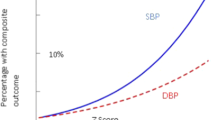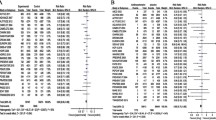Abstract
There are many drug studies for the treatment of hypertension. Most studies compare one drug with another to determine if a drug or class of drugs have unique benefits. In evaluating drug trials, separation of hypertension as compared with atherosclerotic events is important. Trials that focus on prevention of hypertension, especially with new noninvasive markers, may have a bigger part in reducing morbidity and mortality due to elevated blood pressure
Similar content being viewed by others
References and Recommended Reading
DeQuattro V: Evidence-based antihypertensive therapy: a review of ongoing and recently concluded trials. Cardiology 1998, 4:33–37.
National High Blood Pressure Education Program; U.S. Department of Health and Human Services; Public Health Service; National Institutes of Health; National Heart, Lung, and Blood Institute. The Sixth Report of the Joint National Committee on Prevention, Detection, Evaluation, and Treatment of High Blood Pressure, November 1997. NIH Publication No. 98-4080. The JNC VI Report is required reading for physicians. The classification based not only on blood pressure levels but also comorbidity is probably a forward step in treatment of hypertension.
Sever PS, Mackay JA.: The hypertension trials. J Hypertens 1996, 14(suppl 2):S29-S34.
Slataper R, Vicknair N, Sadler R, et al.: Comparative effects o different antihypertensive treatments on progression o diabetic renal disease. Arch Intern Med 1993, 153:973–980.
UK Prospective Diabetes Study Group: Efficacy of atenolol and captopril in reducing risk of macrovascular and microvascular complication in type 2 diabetes (UKPDS 39). BMJ 1998, 7:713–720. The benefits of antihypertensive drug therapy were superior to lowering blood glucose among diabetics especially for macrovascular disease. All diabetics need very careful monitoring and treatment of hypertension.
Gorelick PB, Sacco RL, Smith DB, et al.: Prevention of a first stroke: a review of guidelines and multidisciplinary consensus statement from the National Stroke Association. JAMA 1999, 281:1112–1120. The article provides an important outline for the prevention of stroke. The more aggressive approach to prevention will reduce morbidity and mortality due to stroke.
Zanchetti A: Goals of antihypertensive treatment: prevention of cardiovascular events and prevention of organ damage. Blood Press 1992, 1:205–211.
Gueyffier F, Boutitie F, Boissel JP, et al.: Effect of antihypertensive drug treatment on cardiovascular outcomes in women and men: a meta-analysis of individual patient data from randomized, controlled trials. Ann Intern Med 1997, 126:761–767.
Klungel OH, de Boer A, Paes AHP, et al.: Sex differences in the pharmacological treatment of hypertension: a review o population-based studies. J Hypertens 1997, 15:591–600.
Klag MJ, Whelton PK, Randall BL, et al.: End-stage renal disease in African-American and white men: 16-year MRFIT findings. JAMA 1997, 277:1293–1298. There is an increase in hypertensive related end-stage renal disease possibly related to better ascertainment. The rates are much higher among blacks. The efficacy of antihypertensive therapy is not as clear as for other end points.
Neaton JD, Kuller L, Stamler J, et al.: Impact of systolic and diastolic blood pressure on cardiovascular mortality. In Hypertension: Pathophysiology, Diagnosis, and Management, edn. 2. Edited by Laragh JH, Brenner BM. New York: Raven Press, Ltd.; 1995:127–144.
Neaton JD, Kuller LH, Wentworth D, et al.: Total and cardiovascular mortality in relation to cigarette smoking, serum cholesterol concentration, and diastolic blood pressur among black and white males followed for up to five years. Am Heart J 1984, 108:759–770.
Corol P, Pers A, Geminis-Roqueplo AP, et al.: Seven lessons from two candidate genes in human essential hypertension: angiotensinogen and epithelial sodium channel. Hypertension 1999, 33:1324–1331. The interaction of a genotype with specific drug therapy may in part determine efficacy of therapy. To date few good candidate genes have been identified.
Gorelick PB: Stroke prevention: windows of opportunity and failed expectations? A discussion of modifiable cardiovascular risk factors and a prevention proposal. Neuroepidemiology 1997, 16:163–173.
Textor SC: Cost-effective treatment of hypertension. Cardiology Special Edition Summer/Fall 1997.
Mancia G, Lanfranchi A, Turri C, et al.: Can good surrogate endpoints predict the prognosis of hypertensive patients? J Hypertens 1998, 16(suppl 15):S3-S7.
Hebert PR, Moser M, Mayer J, et al.: Recent evidence on drug therapy of mild to moderate hypertension and decreased risk of coronary heart disease [commentary]. Arch Intern Med 1993, 153:578–581.
Guidelines Subcommittee of the World Health Organization-International Society of Hypertension (WHO-ISH) Mild Hypertension Liaison Committee: 1999 World Health Organization -International Society of Hypertension guidelines for the management of hypertension. J Hypertens 1999, 17:151–183.
Multiple Risk Factor Intervention Trial Research Group: Baseline resting electrocardiographic abnormalities, antihypertensive treatment, and mortality in the Multiple Risk Factor Intervention Trial. Am J Cardiol 1985, 55:1–15.
The Hypertension Detection and Follow-up Program Cooperative Research Group: The effect of antihypertensive drug treatment on mortality in the presence of resting electrocardiographic abnormalities at baseline: the HDFP experience. Circulation 1984, 70:996–1003.
Kahan T: The importance of left ventricular hypertrophy in human hypertension. J Hypertens 1998, 16(suppl 7):S23-S29.
Svetkey LP, Simons-Morton D, Vollmer WM, et al.: Effects of dietary patterns on blood pressure: subgroup analysis of the Dietary Approaches to Stop Hypertension (DASH) randomized clinical trial. Arch Intern Med 1999, 159:285–293. The DASH Study provides an interesting approach to prevention of hypertension. The trial, however, was very short-term and of small sample size. It is unclear whether results persisted over time.
Elias MF, Wolf PA, D’Agostino RB, et al.: Untreated blood pressure level is inversely related to cognitive functioning: the Framingham Study. Am J Epidemiol 1993, 138:353–364.
Snowdon DA, Greiner LH, Mortimer JA, et al.: Brain infarction and the clinical expression of Alzheimer disease: the Nun Study. JAMA 1997 277:813–817. The study suggested that brain infarction and pathophysiology of Alzheimer’s disease are both determinants of dementia. It is possible that treatment and prevention of elevated blood pressure could reduce risk of dementia.
Kuller LH, Shemanski L, Manolio T, et al.: Relationship between ApoE, MRI findings, and cognitive function in the Cardiovascular Health Study. Stroke 1998, 29:388–398.
Breteler MMB, van Amerongen NM, van Swieten JC, et al.: Cognitive correlates of ventricular enlargement and cerebral white matter lesions on magnetic resonance imaging: the Rotterdam Study. Stroke 1994, 25:1109–1115.
Forette F, Seux ML, Staessen JA, et al.: Prevention of dementia in randomized double-blind placebo-controlled Systolic Hypertension in Europe (Syst-Eur) trial. Lancet 1998, 352:1347–1351. The Systolic Hypertension in Europe trial is the first report of a possible decreased risk of dementia with treatment of hypertension. The size of the study, number of cases of dementia, and quality of diagnosis are limiting variables.
Gorelick PB: Can we save the brain from the ravages of midlife cardiovascular risk factors? Neurology 1999, 52:1114–1115.
Post SG: Future scenarios for the prevention and delay of Alzheimer Disease onset in high-risk groups: an ethical perspective. Am J Prev Med 1999, 16:105–110.
Author information
Authors and Affiliations
Rights and permissions
About this article
Cite this article
Kuller, L.H. Issues of clinical trial design and data interpretations in hypertension. Current Science Inc 1, 357–362 (1999). https://doi.org/10.1007/s11906-999-0046-1
Issue Date:
DOI: https://doi.org/10.1007/s11906-999-0046-1




